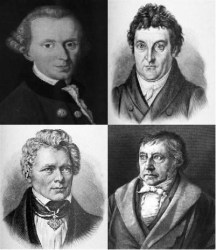
The popular contemporary theorist Zizek published a massive work on Hegel entitled Less Than Nothing, in which he wrote that all of philosophy before the Critique of Pure Reason was a mere precursor to Kant, and that the fifty years between the publication of the Critique of Pure Reason in 1781 and the death of Hegel in 1831 was the critical time of philosophical development in Europe.
It was the time that Kant, Fichte, Schelling and Hegel, whom Zizek the gang of four, changed Continental philosophy forever. Fichte and Schelling are often presented as a bridge between the thinking of Kant and Hegel. This week, we will briefly examine the central ideas of Fichte and Schelling, then look at the central ideas of Hegel’s Phenomenology and Logic. Last time I mentioned that, following Kant, Phenomenologists are concerned with the systematic ways we experience things, the way that they appear for us as phenomena and provide the structure and arrangement of our shared reality.
As mentioned the first week, British and American Analytic philosophy broke from the Continental German and French tradition after Kant, charging Hegel and others with obscurity and needless complexity. The Continental tradition certainly follows Kant in being difficult to understand and long-winded, though deep and meaningful for those who take the time to understand.
Martin Jay, a renowned expert on the Frankfurt School who taught me Hegel, once said in class that reading Hegel is like wading through a swamp. Heidegger and other Continental thinkers, who were each vying to be the next Kant or Hegel in the German philosophical tradition, follow in this tradition. Thus, before cracking the works for oneself, it is often very helpful to have a guide give an overview of German Idealism and its central concepts, such that one does not have to be overwhelmed by the primary sources, or learn about German Idealism on the street.
Johann Gottlieb Fichte (1762 – 1814 CE), like Hegel and many of his day, was inspired by the French Revolution and Kant’s Critiques, so much so that he went to Konigsberg to meet Kant. Kant was not very impressed with his young follower after a disappointing meeting, and so Fichte threw himself into work that would prove himself worthy. At first, Fichte’s anonymous writings were considered the work of Kant himself. As a professor, like Schelling and Hegel, Fichte taught many students who would go on to become central Continental philosophers such as Schopenhauer who we will study next lecture. After Fichte wrote a work arguing that there effectively was no god other than rational morality, he was dismissed from his professorship for atheism. Recall that Kant had no love for religious ceremony, but believed in the purity and objectivity of reason and morality.
Like the Realists mentioned last time, Fichte claimed that a gap between our experience and the objective thing left open the possibility of insurmountable skepticism, the unknowable nature of Kant’s thing-in-itself. Like Hegel, Fichte argued that our reality is mental representation, and the incompleteness of our representations is a part of the representations themselves. Rather than say that there is an objective reality apart from its subjective appearance, Fichte argued that reality is its appearance, insofar as it exists for us.

Like Hegel, Fichte argued that self-consciousness is a social phenomena, critical for future Continental philosophy. As mentioned, the Analytic tradition avoids historical and social context, seeking the objective and universal. The thinkers we have covered so far, from Descartes through Kant, considered self-consciousness to be fundamental to experience, but spoke of it as personal and singular, not historical and cultural. For post-Hegelian Continental thought, reality is a social construct, a synthesis of individual, social and real. Reality is intersubjectivity. Objectivity is collective subjectivity. This does not mean that every communal belief is as true as every other, but that objectivity and reality are socially understood and construed.
Fichte argued that it is through others that we find ourselves called to obedience as well as freedom. Being, as self-consciousness, is a calling or summons, Aufforderung in the German, a term taken up later by Heidegger. The individual, the “I” (Das Ich), asserts itself, and this assertion, drive and direction is the existence of the “I” as well as its basic activity. It is in accord and against this assertion of self that phenomena take place. This became a central idea for Hegel as well as Freud, who used the Greek word for self, ego. The ‘I’ discovers its limits through its interactions with others and the resistance (Anstoss) of others. Hegel’s view of history and master/slave dialectic is founded on this idea of recognition evolving through a process of resistance.
I am reminded of an experience I had as a preschooler at a friend’s birthday party. After the piñata had been thoroughly dismembered, my friend had a whole leg to herself. Without thinking about her perspective or desires I reached out to grab it. She shrieked and pulled it out of my grasp, which shocked me into recognizing that I had not bothered to think beyond my own perspective and desires. There is a story in the Daoist work Liezi about a man who sees gold in the marketplace, grabs it and runs. When asked later by the police why he would do such a thing in broad daylight, he told them that at the time he did not see the people, only the gold. Developmental psychologists tell us that in preschool, as we begin to socialize, we begin to represent the perspectives and desires of others to make sense of conflicts between ourselves and others.
Unfortunately, Fichte became a bit too social in hearing the calling of German Nationalism, as well as antisemitism and misogyny, arguing that the Germans must assert their Germanness and that Jews and women should not be included in the state or given rights. Unsurprisingly, many Nazis were far more into Fichte than Hegel, who they identified with the rise of Marx and Communism, an internationalist enemy of nationalist fascism. Fichte, like the Nazis who would rise over a hundred years after his death, believed in the original German people, the Volk. Later, Nietzsche rejected German Nationalism and antisemitism, which he saw as a source of fear and weakness, while Heidegger embraced the idea of the German Volk through the lens of Fichte, seeing it as a source of unity and strength.








